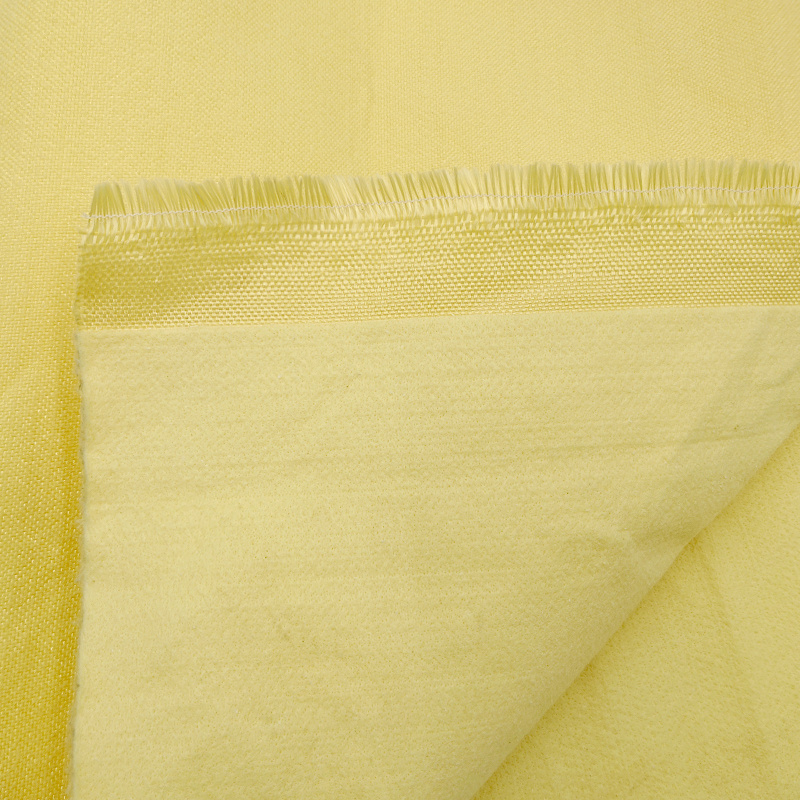Aramid 1414 filament fabric-composite nonwoven material for aircraft and high-speed train interior applications
Oct 15,2025

Aramid 1414 filament fabric-composite nonwoven fabric is a multi-layered composite material created by combining aramid 1414 filament woven fabric with aramid nonwoven fabric through a specialized manufacturing process. Aramid 1414 filament fabric is produced by weaving aramid 1414 filaments into plain or twill weaves, offering exceptional properties such as high strength, high modulus (tensile strength up to 2200 MPa), excellent impact resistance, cut protection, and superior dimensional stability. Meanwhile, aramid nonwoven fabric is crafted by needle-punching short aramid fibers into a felt-like material, endowing it with outstanding features like thermal insulation, filtration and adsorption capabilities, and remarkable heat resistance.
Characteristics of Aramid 1414 Filament Fabric-Composite Nonwoven Material
1. Excellent mechanical properties
High Strength and High Modulus : Aramid 1414 filament is the "skeleton" of the material—its specific strength (strength per unit weight) is 5 to 6 times that of high-quality steel, while its specific modulus is 2 to 3 times higher than steel. This gives the composite material exceptionally high tensile strength and remarkable durability.
Excellent impact resistance and cut resistance : Aramid fibers possess a unique "liquid crystal" structure and molecular chain orientation, enabling them to rapidly dissipate impact energy along the fiber direction while absorbing substantial amounts of energy. As a result, the resulting composite materials exhibit exceptional resistance to tearing, puncture, and abrasion. Flexibility and Dimensional Stability : High in strength, aramid fabric maintains excellent flexibility, making it easy to process and conform to complex curved surfaces. At the same time, it exhibits low thermal shrinkage, ensuring stable shape and dimensions even under varying temperature and humidity conditions.
2. Excellent high-temperature resistance and flame-retardant performance
Flame-retardant and fire-resistant : The flame retardancy of aramid is determined by its molecular chain structure—specifically, the presence of aromatic rings and amide bonds—and is an intrinsic property of the material. It does not degrade over time due to washing, abrasion, or exposure to environmental factors. Typically, aramid boasts a limiting oxygen index (LOI) greater than 28, meaning it cannot sustain combustion in atmospheres where oxygen concentration falls below 28%. Moreover, once removed from the ignition source, aramid will self-extinguish promptly.
High-temperature resistant, non-dripping : It features a wide long-term operating temperature range, from -196°C to 204°C. Even when continuously exposed to a high temperature of 260°C for 100 hours, it retains 70% of its original strength. Moreover, at extremely high temperatures up to 370°C, it does not melt like conventional synthetic fibers—instead, it slowly chars without producing molten droplets. This characteristic is crucial in protective applications, as it prevents secondary burns by eliminating the risk of scalding drips.
High strength retention rate at high temperatures : In high-temperature environments, it exhibits minimal loss of mechanical strength, which is why it can serve as the foundation for high-temperature filters and high-temperature conveyor belts.
3. Stable Chemistry and Durability
Chemically resistant It exhibits excellent resistance to most common organic solvents and fuel oils. However, it’s important to note that its tolerance for strong acids (such as concentrated sulfuric acid or nitric acid) and strong bases is limited—prolonged exposure can lead to a reduction in strength.
Hydrolysis-resistant and age-resistant : It maintains stable performance in hot and humid environments, is resistant to hydrolysis, and exhibits superior UV resistance compared to many other high-performance fibers, ensuring an exceptionally long service life.
Applications of Aramid 1414 Filament Fabric-Composite Nonwoven Materials
High-Temperature Industrial Flue Gas Filtration (Baghouse Dust Removal)
Application scenarios include the purification and treatment of high-temperature, highly corrosive flue gases generated from cement plant rotary kiln heads/kiln tails, steel plants' blast furnaces/converter/electric furnaces, coal-fired boilers, waste incinerators, carbon black plants, and more.
How it works: In a baghouse dust collector, the filter bags are the core component.
Nonwoven fabric layer (usually the surface layer): Responsible for surface filtration, forming an initial dust layer that efficiently captures ultrafine particulate matter, achieving a filtration efficiency of 99.99% or higher.
The continuous filament fabric layer (acting as a reinforcing skeleton) provides mechanical support, effectively withstanding the significant pressure differentials—whether positive or negative—as well as the impact of airflow during the filter cleaning process. This prevents the filter bags from collapsing inward or over-expanding, thereby avoiding damage and ensuring reliable long-term operation.
Advantages: Compared to traditional polyester and PPS filter materials, it can withstand higher temperature fluctuations and more demanding chemical environments, resulting in a longer service life.
Specialized Protective Clothing and Equipment
Firefighting suits, industrial thermal protective clothing:
Outer layer: Made from aramid 1414 filament fabric, leveraging its abrasion-resistant, scratch-proof, and tear-resistant properties to withstand damage from external flames and sharp objects.
Insulation layer: Made from aramid non-woven fabric or needle-punched felt, this material leverages its fluffy, porous structure to effectively block heat transfer, creating a stable air-based insulation layer.
This "externally flame-retardant, internally insulating" composite structure provides comprehensive life protection for firefighters, welders, and petrochemical workers.
Cut-resistant gloves and apparel:
Used in mechanical processing, metal glass applications, the slaughtering industry, and more. The high-strength filament fabric effectively resists cutting from sharp edges, ensuring protection for operators.
High-performance bulletproof armor:
Although bulletproof vests commonly use aramid 1414 non-woven fabric (UD fabric) laminates, filament-based composite structures are also employed in applications such as vehicle armor and helicopter bulletproof panels—scenarios that demand higher rigidity and resistance to multiple impacts. By combining these materials with others, like ceramics or polyethylene, lightweight yet highly effective composite armor systems are created.
High-end Industry and Advanced Composite Materials
Aerospace and Transportation:
Aircraft/high-speed rail interior materials: Leveraging their flame-retardant, lightweight, and low-smoke-toxicity properties to enhance safety.
Rubber-reinforced products: Used as high-temperature hoses (such as automotive turbocharger pipes, oil-resistant hoses, and brake hoses), conveyor belts (including heat-resistant conveyor belts), and as the reinforcing material for aircraft tire carcass fabrics, imparting to these products high strength, excellent heat resistance, and outstanding fatigue performance.
Building Structure Reinforcement:
After impregnating aramid filament fabric with resin, it is adhered to the surface of concrete structures for seismic reinforcement of bridges, piers, and tunnels. Its advantages include high strength, lightweight design, excellent corrosion resistance, ease of construction, and the ability to enhance structural integrity without increasing the cross-sectional dimensions of the original structure.
Electrical insulation:
Insulating materials used for motors and transformers, such as slot insulation and phase-to-phase insulation, are prized for their high-temperature resistance, flame retardancy, and excellent dielectric strength.
Other emerging applications
High-temperature conveyor belt: Used in processes such as reflow soldering for electronic products and high-temperature baking of food, these conveyor belts are required to maintain stable dimensions, resist sticking, and withstand high temperatures.
Sealing and Gasket Materials: Seals designed for high-temperature and high-pressure environments, such as cylinder gaskets.
Related Posts
Contact Us
E-mail:
gdkaidun@163.com
Phone/WeChat:
86-131-3828-6677
Address:
Room 401, Building 21, No. 1, Keqing Road, Yundonghai Street, Sanshui District, Foshan City, Guangdong Province





